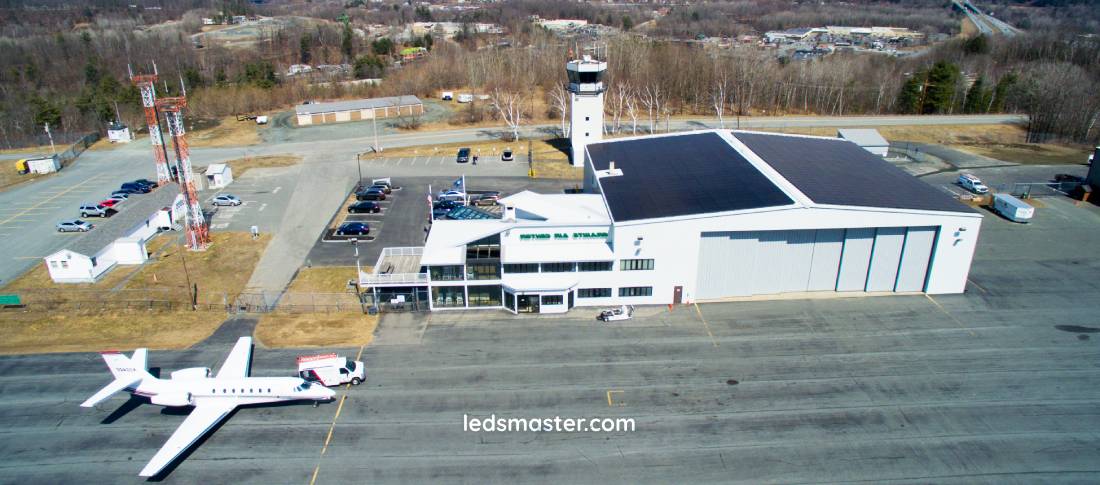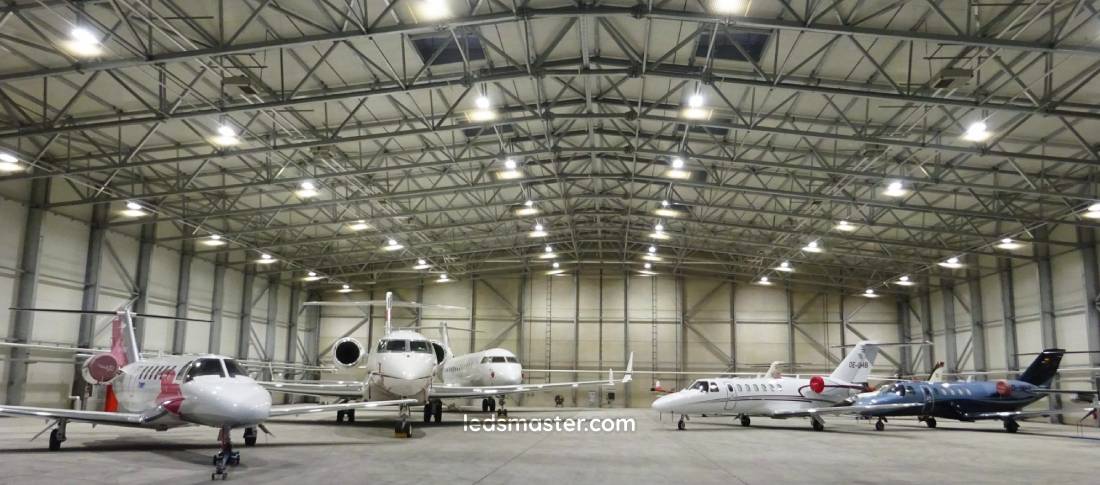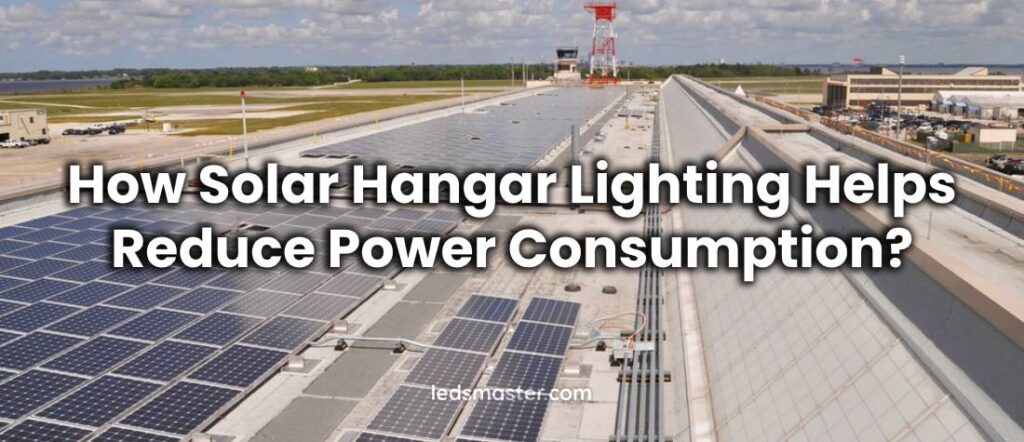Solar hangar lighting systems are becoming increasingly popular due to their ability to lower energy consumption while providing reliable illumination for large spaces like aircraft hangars. These systems use photovoltaic (solar) panels to convert sunlight into electricity, which is then used to power lighting fixtures. As industries strive to reduce their carbon footprint and operational costs, solar-powered solutions offer a promising alternative to traditional lighting systems. In particular, hangars, with their vast size and extended operational hours, benefit greatly from the switch to solar-powered lighting. This shift not only helps reduce dependence on grid electricity but also leads to long-term savings on energy bills.
Table of Contents
ToggleHow Solar Lighting Works in Hangars

Solar hangar lighting systems function by harnessing sunlight through solar panels. These panels collect sunlight and convert it into electrical energy using photovoltaic cells. The electricity generated is then stored in batteries for use during non-sunny periods, such as nighttime or cloudy days. The stored energy powers the lighting systems, which can range from LED fixtures to more traditional types of bulbs. The setup is designed to maximize energy efficiency, ensuring that the hangar remains illuminated while reducing the need for constant grid power consumption. Solar lighting systems also include controllers that manage the flow of energy, ensuring that batteries are charged efficiently and the lighting operates as needed without wasting energy.
Reduction in Grid Dependence
One of the primary advantages of solar hangar lighting is its ability to reduce reliance on grid electricity. By generating power from sunlight, these systems provide a renewable energy source that decreases the need for traditional power from utility companies. For hangars, which are often large and require a substantial amount of lighting, this reduction in grid consumption can be a game-changer in terms of energy costs. With solar panels installed on the roof of the hangar, the building can generate enough energy to meet the lighting needs during the day and store excess energy for use at night. Over time, this results in a lower energy bill and reduced environmental impact as less power is drawn from non-renewable sources.
Energy Efficiency of LED Lighting in Solar Systems

LED lighting, commonly used in solar hangar systems, is known for its energy efficiency. Compared to traditional incandescent or fluorescent bulbs, LEDs consume significantly less power to produce the same amount of light. This efficiency makes them particularly suitable for solar-powered systems, where energy conservation is a key priority. In a solar system, where power storage is limited, it is important to maximize the utility of every bit of stored energy. LED lights are designed to use a minimal amount of electricity while still providing optimal brightness, ensuring that the system operates efficiently even when the available energy is less than abundant.
Low Power Consumption of LEDs
One of the primary reasons why LEDs are preferred in solar-powered systems is their low power consumption. While traditional incandescent bulbs are notorious for wasting energy in the form of heat, LEDs convert almost all of the electrical energy into light. This translates to a much higher efficiency rate, as they require far less energy to generate the same amount of brightness. For solar hangar lighting, this low power consumption ensures that the energy produced by the solar panels can be used more effectively, especially in large spaces that require consistent illumination.
Longer Lifespan and Reduced Waste
Another advantage of LED lighting in solar systems is its longevity. LED bulbs have a significantly longer lifespan compared to incandescent and fluorescent lights. While incandescent bulbs may last for around 1,000 hours, and fluorescent bulbs typically last about 8,000 hours, LEDs can last up to 50,000 hours or more. This durability means that LEDs need to be replaced far less often, reducing maintenance costs and the amount of waste generated by bulb replacements. For hangar operators, this longevity is especially beneficial, as it minimizes the hassle and cost of frequent bulb changes, making the system even more cost-effective over the long term.
Optimal Performance in Solar-Powered Systems
LED lights are particularly well-suited for use in solar-powered systems due to their ability to function efficiently with lower voltage levels. Unlike traditional lighting, which may struggle with fluctuating power supply, LEDs maintain their performance even in environments where energy supply is limited or variable. Since solar panels charge batteries that supply power to the lighting system, LEDs ensure that the stored energy is utilized efficiently. This becomes especially important in hangars, which may experience extended periods of low natural light, as the energy needs to be conserved and used wisely to maintain consistent lighting for long durations.
Reduced Heat Emissions for Better Efficiency
LED lights are also known for producing very little heat compared to traditional lighting options. Incandescent bulbs, for example, emit up to 90% of their energy as heat, wasting a large portion of the power they consume. On the other hand, LEDs produce very little heat, making them much more efficient in terms of energy use. This reduction in heat emission not only contributes to energy savings but also ensures that the solar-powered system operates efficiently. The cooler operation of LEDs also helps prolong the life of the solar panels and batteries, which may degrade faster if subjected to excessive heat.
Lower Energy Demand on Solar Batteries
Since LEDs consume less power, they place a lower demand on the batteries that store energy from the solar panels. In solar-powered lighting systems, the batteries play a crucial role in ensuring that lights remain operational after sunset or on cloudy days. Because LEDs require less energy to operate, the battery charge lasts longer, meaning fewer recharges are necessary and reducing the overall wear on the battery system. This results in longer battery life and fewer replacements, further improving the cost-effectiveness and sustainability of solar hangar lighting systems.
Better Light Distribution and Uniformity
LED lights offer better light distribution compared to traditional bulbs, which often have a narrow beam angle or uneven light output. LEDs are designed to distribute light more evenly across a space, ensuring that the hangar is illuminated consistently without dark spots or harsh contrasts. This uniformity not only improves the visibility within the hangar but also reduces the need for additional lighting fixtures. With fewer lights required to achieve the desired brightness, the overall energy consumption is reduced, allowing the solar-powered system to operate more efficiently with less power demand.
Cost Savings Over Time
While the upfront cost of installing a solar lighting system may seem higher compared to traditional lighting, the long-term financial benefits are undeniable. One of the most significant advantages of solar hangar lighting is its ability to drastically reduce ongoing energy expenses. By relying on solar power rather than grid electricity, businesses can avoid the rising costs of utility bills. Solar panels, known for their durability, can last for decades with minimal upkeep, allowing hangar operators to enjoy reduced energy costs for years to come. Once the initial investment is recouped, the energy expenses for lighting the hangar decrease substantially, resulting in significant savings over time. Moreover, governments often offer tax incentives and rebates for businesses investing in renewable energy solutions, which can further offset installation costs and make the transition to solar more affordable.
Optimized Energy Usage with Advanced Solar Technology
Modern solar lighting systems are equipped with cutting-edge technologies that optimize energy use, ensuring that every watt of solar energy is used efficiently. For instance, smart controllers and sensors are integrated into the system to adjust the lighting based on environmental factors. During the day, when enough natural light enters the hangar, the lighting system can dim or turn off entirely, reducing unnecessary energy consumption. Additionally, motion sensors can detect activity within the hangar, turning on the lights only when the space is in use. This level of precision in energy management ensures that electricity is consumed only when necessary, further reducing the overall energy usage and contributing to ongoing cost savings.
Durability and Low Maintenance Requirements
Another key advantage of solar hangar lighting is its minimal maintenance needs. Solar-powered systems are designed for durability and reliability, with components such as solar panels, batteries, and LED lights built to endure harsh conditions. These systems are resistant to temperature fluctuations and exposure to outdoor elements, making them ideal for use in a hangar environment. Solar panels, in particular, have no moving parts, which means they experience less wear and tear over time compared to traditional lighting systems. Maintenance is generally limited to cleaning the panels to ensure they continue to capture maximum sunlight and checking the battery to ensure it holds a charge. This contrasts with traditional lighting systems that require frequent bulb replacements and regular electrical repairs, making solar-powered systems a much more low-maintenance solution and further enhancing their cost-effectiveness.
Long-Term Investment and Return on Investment (ROI)
Investing in solar hangar lighting provides businesses with a strong return on investment (ROI) over the years. The combination of reduced energy costs and lower maintenance expenses makes it a sound financial decision. As electricity prices continue to rise, the savings from using solar power become even more significant. Although the initial investment in solar panels and LED lighting systems may be higher, businesses typically see a steady reduction in their energy bills shortly after installation, leading to a full return on investment within a few years. With solar panels and LEDs designed to last for decades, the system continues to provide value over the long term, making it an excellent financial choice for hangar operators looking to reduce their operating costs while enjoying a reliable and sustainable lighting solution.
Environmental Impact and Sustainability
Solar hangar lighting systems have a meaningful role in reducing the environmental impact of a facility by utilizing renewable energy sources. These systems help to decrease the overall carbon footprint of a business by shifting away from traditional lighting methods that rely on fossil fuels. In conventional lighting setups, electricity is typically generated by burning coal, natural gas, or oil, all of which release significant amounts of carbon dioxide (CO2) and other greenhouse gases into the atmosphere. These emissions contribute to climate change and air pollution. Solar energy, on the other hand, is a clean and renewable resource that produces no emissions during its generation process, making it an eco-friendly alternative that helps combat the negative environmental effects associated with fossil fuel consumption.
When a hangar transitions to solar lighting, it effectively reduces its reliance on the grid and, by extension, its dependence on electricity generated by burning fossil fuels. This not only lowers greenhouse gas emissions but also helps reduce air and water pollution. The reduction in energy consumption from non-renewable sources is vital for businesses looking to lessen their environmental impact. With growing awareness around the urgency of addressing climate change, many businesses are exploring ways to integrate more sustainable practices into their operations. Solar lighting offers a practical and effective solution that aligns with these goals, allowing hangars and other large facilities to take direct action in minimizing their carbon footprint.
Moreover, the environmental benefits of solar hangar lighting extend beyond just reducing emissions. Solar energy is an inexhaustible resource, unlike fossil fuels, which are finite and will eventually be depleted. By harnessing the sun’s energy, hangar owners are adopting a sustainable energy model that ensures they are not contributing to the depletion of non-renewable resources. The use of solar lighting supports long-term sustainability, as solar panels can produce clean energy for decades, unlike fossil fuel-based power plants, which require ongoing extraction, transportation, and processing of natural resources. This sustainability aspect not only benefits the business but also plays a part in contributing to the broader global effort to transition towards cleaner, more sustainable energy sources.
Beyond the immediate reduction in greenhouse gas emissions, solar hangar lighting also aids in reducing the environmental impact of the lighting industry as a whole. The production and disposal of traditional light bulbs, particularly incandescent and fluorescent types, can have significant environmental consequences. These bulbs often contain hazardous materials like mercury, which pose a threat to ecosystems if not disposed of properly. On the other hand, LED lights, which are commonly used in solar systems, are much more eco-friendly in this regard. LEDs are free from hazardous chemicals, and they are fully recyclable, making them a much safer option for both the environment and the people who handle them. This aspect of solar lighting further supports the move towards sustainability by minimizing waste and harmful emissions throughout the lifecycle of the lighting system.
By investing in solar lighting, businesses not only help mitigate climate change but also contribute to the development of a cleaner, healthier world. Solar energy systems, including solar lighting, are inherently sustainable due to their low environmental impact during both their operational phase and end-of-life disposal. As the technology continues to evolve, solar energy will become even more efficient, reducing the costs and improving the performance of these systems. By adopting solar lighting, hangar operators set a positive example for other industries, demonstrating that it’s possible to reduce operational costs while making a meaningful contribution to environmental conservation.
In addition to the environmental advantages, many governments and environmental organizations offer incentives and support to businesses that choose renewable energy solutions. These incentives can include tax credits, grants, and rebates, which can reduce the overall cost of installing solar systems and encourage businesses to make the shift toward sustainable energy. The growing movement towards clean energy means that more resources and tools are available to make these transitions feasible and affordable for businesses of all sizes.
Conclusion
Solar hangar lighting offers a reliable and efficient way to reduce power consumption in large facilities. By harnessing the power of the sun, these systems can significantly lower dependence on grid electricity, helping businesses reduce their energy costs over time. The use of energy-efficient LED lights, along with advanced solar technology, ensures that energy is used optimally, providing a sustainable and cost-effective solution for hangar operations. Furthermore, solar lighting systems have a long lifespan and require minimal maintenance, making them a durable option that can withstand the demands of a hangar environment. While the initial investment may be higher, the long-term financial benefits and environmental advantages make solar hangar lighting an appealing choice for businesses looking to reduce their energy consumption and contribute to a greener future.

